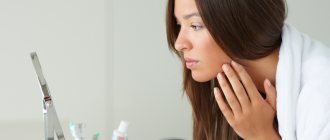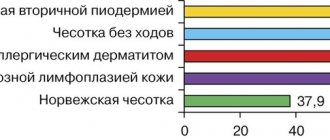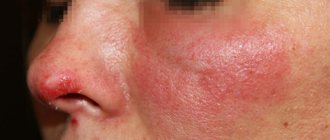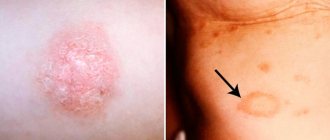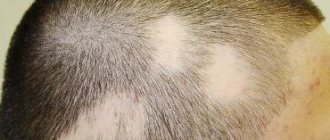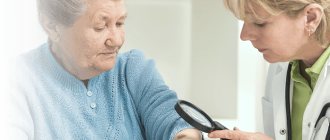Lichen planus is a chronic disease, prone to relapse, which is accompanied by itchy skin and inflammatory rashes in the form of purple papules.
This disease often affects the mucous membranes of the mouth or genitals. According to WHO, lichen planus accounts for about 2.5% of all dermatological diseases and 15% of diseases of the oral mucosa.
The complex of diseases that make up lichen planus includes two syndromes: Little-Lassuere syndrome, including non-scarring alopecia of the armpits and pubis and scarring alopecia of the scalp, as well as Grinshpan-Potekaev syndrome, including diabetes, hypertension and an erosive-ulcerative form of the dermatological disease.
The exact cause of the pathology is unknown. There are neurogenic, viral, bacterial, autoimmune and toxic-allergic theories of the nature of the disease.
There are a number of factors that increase the likelihood of developing lichen planus, namely:
- genetic predisposition;
- nervous system disorders;
- failure of immunity;
- allergic (lichenoid) reactions to chemical or food components;
- chronic infections in the body;
- metabolic disorders;
- stress;
- injuries to the skin and oral mucosa (presence of sharp edges of teeth, poorly made dentures);
- changes in the microelement composition of saliva due to the presence of dentures made of different metals in the oral cavity;
- aggressive effect of certain medications;
- age after 40 years, etc.
Treatment of this disease is complex and requires an individual approach. Based on the test results, the doctor selects a regimen and dosage of drugs, usually of local action, which reduce the symptoms of the pathology and prevent its reappearance.
What is lichen planus?
Lichen planus is an inflammatory dermatosis with various clinical manifestations. The pathological process involves skin tissue and its appendages (nails and hair), as well as mucous membranes. Usually the disease affects representatives of both sexes of middle and older age, but sometimes it is observed in children.
In modern medicine, it is believed that lichen planus is a delayed-type hypersensitivity reaction in response to the action of a neoantigen of epidermal (skin) origin, since the autoimmune aspect has a significant place in the nature of the disease. Cytokines released by immune cells provoke cytotoxic mechanisms and trigger cell death (apoptosis).
Lichen planus is characterized by three stages:
- progressive, which is accompanied by the active manifestation of symptoms of the pathology: the formation of papules and itching;
- stationary with a gradual decrease in signs of the disease: pallor, flattening of papules and subsidence of itching;
- regressive, which is characterized by regression of papules, the formation of brown spots and areas of atrophy at the site of their localization, and the disappearance of itching.
Ointments for treating skin
Therapy for dermatosis always involves an integrated approach. It combines restorative and antihistamine treatment. The following creams and ointments are usually prescribed for topical use:
- Advantan
. Hormonal ointment is intended to relieve swelling and severe itching and restore tissue. It does not have a systemic effect on the body. - Celestoderm
. Hormonal ointment is characterized by a wide spectrum of action. It has a rapid anti-inflammatory effect, negatively affects bacteria introduced into the body, and relieves itching. One of the components is a broad-spectrum antibiotic, gentamicin. - Fenistil
. The gel belongs to the category of antihistamines. The active ingredients block receptors for elements sensitive to allergens, cool the skin and relieve itching. The medicine is applied in a thin layer, but no more than 3 times a day. During the treatment period, it is important to avoid exposure to UV rays.
To treat the atrophic form of lichen ruber, it is unacceptable to use products with corticosteroids. To eliminate the disease, Fenistil or Gistan are usually prescribed. However, after using the latter, pigment spots may appear on the skin at the points of application.
How to identify lichen planus?
The external manifestation of lichen planus is caused by the processes of damage and regeneration of skin cells and mucous membranes.
The following symptoms are characteristic of lichen planus:
- the presence of polygonal, flat-topped, colored papules 1-2 mm in diameter;
- grouping of papules with the formation of rings or lines;
- the formation of large plaques from papules (Wilham stack), along the periphery of which isolated small papules are located;
- symmetrical localization on the skin (wrist joints, forearms, legs, genitals, etc.);
- the appearance of neoplasms on the inside of the cheeks, gums, tongue, red border of the lips or genitals when the mucous membrane is damaged;
- thinning, brittleness, clouding of the nail plates;
- pronounced itching;
- rapid appearance of papules due to skin injuries (Koebner phenomenon);
- formation of secondary hyperpigmentation in place of the disappeared papule.
Doctors classify the main morphological forms of lichen planus as:
- typical, most common (45% of cases) form of pathology, accompanied by the formation of pearl-colored papules with a specific coating;
- hyperkeratotic or verrucous, characterized by the formation of hard red, gray-yellow or dark red infiltrated plaques on the front of the leg or upper limbs;
- exudative-hyperemic (25% of cases), causing the formation of edematous papules;
- erosive-ulcerative, often resulting from exudative-hyperemic lichen and accompanied by the formation of small ulcers or areas of erosion on the feet or in the interdigital space, etc.
Also in some cases, rare bullous, atypical and pigmented forms of the disease are observed.
The appearance of the first signs of the disease requires immediate medical response. Lack of timely treatment can lead to rapid progression of the pathology and a significant weakening of the body's defenses. What tests are done for lichen planus?
Typically, the diagnosis of lichen planus includes:
- blood test (general and biochemical);
- hormonal profile;
- scraping for histological and cytomorphological examination (affected tissues are susceptible to hyperkeratosis, degeneration of the epidermis, the presence of infiltrate, etc.);
- skin biopsy;
- consultation with a dentist and other related specialists (endocrinologist, gastroenterologist).
When visiting a doctor, it is extremely important to provide him with a list of medications taken, episodes of recent dental treatment, vaccination or viral disease. History data will greatly help in making the correct diagnosis and determining the nature of the origin of lichen planus.
Features of treatment
If you suspect lichen, you should immediately visit a specialized specialist - a dermatologist. To confirm the disease, the doctor prescribes a comprehensive examination, including blood tests, a biopsy of the affected area, and allergy tests. Differential diagnosis plays an important role during the examination.
At the initial stage, skin rashes can easily be confused with a common allergy, and neoplasms in the mouth may resemble stomatitis in symptoms.
| Group of drugs | Examples of medications |
| Corticosteroids to reduce the activity of the immune system. | Prednisolone |
| Ointments for relieving itching and cooling the skin | Flucort, Flucinarom, Advantan, Triderm |
| Antihistamines | Claritin, Erius, Tavegil, Suprastin |
| Antibiotics | Erythromycin, Sumamed, Metacycline |
| Vitamin complexes | Tocopherol, Neovir |
Treatment of the disease is complex and carried out at home. In 70% of cases, it is accompanied by other health problems, so the fight against dermatological disease begins with their treatment. Then the patient is prescribed specific therapy, including medications from the table above.
Medicines containing corticosteroids
Corticosteroids are preparations of adrenal hormones. They relieve inflammation and allergic reactions well. Treatment of lichen ruber most often begins with the prescription of corticosteroids in the form of creams and ointments. In the absence of a visible therapeutic effect, they are replaced with a tablet form. When the tablets do not give the desired result, they move on to injections.
One of the popular tablet drugs is Prednisolone. The components included in its composition reduce the dynamics of lymphocytes and block the possibility of their movement directly to the site of inflammation. To treat red lichen, it is taken every other day, 25 mg. The duration of therapy is determined by the doctor, as a rule, does not exceed 2 weeks. Within a few days after starting treatment, itching and swelling decrease, and rashes disappear. After abrupt discontinuation of the drug, recurrence of symptoms cannot be ruled out.
Antihistamines
Antihistamines are used to relieve itching and reduce the activity of allergens. After their use, epithelization of lesions is observed in some patients. The doctor prescribes antihistamines only if the cause of lichen ruber is direct contact with an allergen. When a pathological process is caused by a malfunction of internal organs, their use is considered inappropriate. The following medications in tablet form are characterized by the greatest effectiveness: Claritin, Erius, Tavegil, Suprastin.
In case of a severe allergic reaction, drugs are prescribed in courses of 7-10 days. Their action is aimed at blocking cellular receptors that are affected by histamine. If after this period it was not possible to overcome lichen ruber, they move on to hormonal therapy. It is highly undesirable to simultaneously use antihistamines and immunomodulatory drugs. This can aggravate the allergenic reaction and cause the Wickham's grid symptom.
Antibiotics and vitamin complexes
Antibiotics are used exclusively for complicated cases of lichen ruber. They fight pathogenic microflora well. As a rule, tablets from the group of macrolides (Erythromycin, Sumamed) and tetracyclines (Metacycline) are prescribed. Such drugs are not taken in other dosage forms. If there is a progressive infection in the body, Ceftriaxone solution is injected intramuscularly and 3-3.5 g of Amoxicillin is taken. After completing the course of treatment, the patient must take antifungal and immunomodulatory drugs.
To maintain the functioning of the immune system, vitamin complexes (vitamins B, C, D, Tocopherol and Retinol) must be included in the course of therapy. In cases of moderate severity of the disease, they are used in the form of tablets, and in complicated cases - in the form of injections. The complex drug Neovir has proven itself well. Its course use helps reduce vascular permeability and improve protein synthesis in soft tissues.
How dangerous is lichen planus?
Lack of treatment or a severe stage of the disease can lead to damage to the entire skin, severe discomfort and a significant decrease in immunity.
Lichen planus on the scalp can cause irreversible hair loss, and on the nail plates - nail deformation (thinning, splitting, rejection of the nail plate, even nail lysis).
A pathological lesion in the eye area can lead to blurred vision or narrowing of the tear duct.
The erosive form of the disease often leads to the formation of scars, and the result of lesions of the genital mucosa can be narrowing of the vagina or phimosis.
Also, some forms of the disease are prone to malignancy and degeneration into squamous cell skin cancer.
Causes and symptoms of the disease
The pathogenesis of the disease comes down to the incorrect functioning of the immune system when it begins to attack the elements of the dermis. Scientists have not been able to definitively determine the reason why this happens. However, they were able to identify a group of factors, the presence of which increases the likelihood of developing lichen several times:
- genetic predisposition;
- disruptions in the functioning of the nervous system;
- gastrointestinal diseases (gastritis, colitis of various etiologies);
- viral lesions of the body;
- chemical poisoning;
- damage to the oral mucosa;
- long-term use of medications that contain tetracycline, ibuprofen, etc.
At the beginning of the development of the disease, numerous crimson nodules appear on the skin areas. The neoplasms have an irregular shape, and the sizes vary within 2 cm. The surface of the nodules has a specific shine. The nodules can merge together, resulting in the formation of plaques covered with whitish scales. In about a quarter of patients, lichen affects the mucous membranes of the mouth, vagina, or head of the genital organ. The clinical picture is always accompanied by severe itching, which provokes sleep problems and irritability.
How to cure lichen planus?
The composition and tactics of treatment for lichen planus depend on the degree of spread of the lesion, on the cause and localization of the pathology, on information about the effectiveness of previously administered therapy. Thus, treatment of the disease involves the use of systemic and external medications, as well as phototherapy.
Among the most effective medicinal groups of drugs for the treatment of lichen planus, experts identify:
- antihistamines;
- multivitamin complexes;
- antifungal agents;
- systemic corticosteroids;
- systemic retinoids, etc.
Damage to the oral mucosa in LLP
Topical and systemic corticosteroids
Topical corticosteroids are first-line drugs for the treatment of localized forms of LP of the oral mucosa. Strong and very strong drugs - clobetasol, triamcinolone, betamethasone, fluocytonide, fluticasone - have proven effectiveness and safety. These drugs are usually applied 2 times a day, either undiluted (eg clobetasol propionate 0.05%) or mixed with Orabase (eg triamcinolone) for 1-2 months, followed by maintenance use. It is also possible to use GCS in the form of intralesional injections, but there is insufficient data to support the advantage of this method over others (there are only isolated clinical cases). Systemic therapy using oral corticosteroids may be indicated in case of significant severity of the disease, in case of refractory to external therapy, however, the evidence base for this approach is insufficient; adequate placebo-controlled studies have not been conducted. Taking into account the wide range of side effects associated with the use of systemic corticosteroids, this group of drugs is used in the form of a short course with subsequent transition to topical therapy.
Topical calcineurin inhibitors
Interest in the possibility of using topical calcineurin inhibitors was attracted primarily by their anti-inflammatory effect, which is different from tGCs. The mechanism of action of the drugs is realized by suppressing the activity of T cells at the level of transcription factors. Published studies examining the effectiveness of this group of drugs are very contradictory - a meta-analysis performed in 2012, evaluating 3 randomized controlled trials, showed that the effectiveness of pimecrolimus was no greater than placebo. Subsequent studies were more encouraging - according to the data obtained, the effectiveness of topical calcineurin inhibitors was comparable to the effect of tGCs. A 2014 study found that pimecrolimus was slightly more effective than tacrolimus, while more recent studies found that tacrolimus and pimecrolimus were equivalent. These data were confirmed in an open randomized controlled trial (2017), a pilot randomized controlled trial, and a subsequent meta-analysis. Many physicians have found tacrolimus to be more effective in their clinical practice. Side effects of topical calcineurin inhibitors include local irritation and burning, especially on eroded lesions (which limits their use in the case of the erosive form of LP), but in general their safety profile is not inferior to long-term use of corticosteroids. The absence of side effects of TGCS determines increasing interest in the use of these drugs in clinical practice.
Topical and systemic retinoids
Retinoids have certain immunomodulatory effects due to their direct effects on T cells through nuclear retinoic acid receptors. Topical retinoids are an alternative to corticosteroids for non-erosive LP and are recommended as a second-line drug according to World Workshop in Oral Medicine IV. Despite the proven effectiveness of topical tretinoin and isotretinoin 0.1% (in placebo-controlled studies), one study showed lower effectiveness compared to tGCs. Side effects include local irritation, photosensitivity, and teratogenicity. The possibility of disease relapse within 2-5 weeks after stopping use of the drug significantly limits the widespread use of topical retinoids in everyday practice. The use of systemic retinoids (etretinate, isotretinoin) is limited due to an insufficient risk-benefit ratio, however, the use of alitretinoin may be more successful.
Other drugs for treatment
With lichen planus, the functioning of internal organ systems is often disrupted. Therefore, timely and high-quality treatment of other health problems is required. We are talking about such common diseases as diabetes, neuroses, high blood pressure, inflammatory processes in organs. To normalize blood circulation in tissue structures, it is recommended to take vascular medications (Xanthinol, Trental).
If pronounced irritation occurs, which entails sleep problems and worsens a person’s quality of life, the use of sedative and hypnotic medications (Phenazepam, Medazepam) is indicated. They are prescribed exclusively for acute and subacute forms of lichen. The listed tablets are taken for 14 days. the dosage is always selected individually, but in the case of Medazepam it cannot exceed 10 g.
